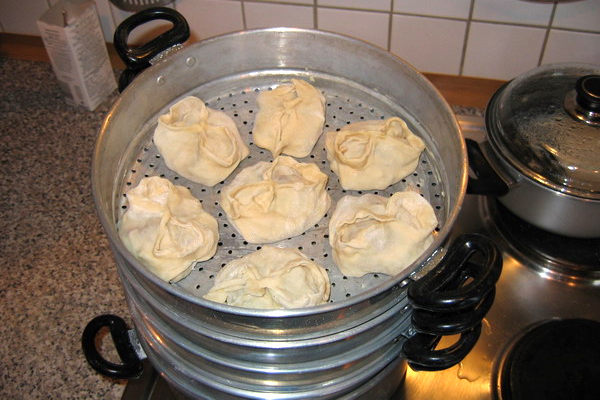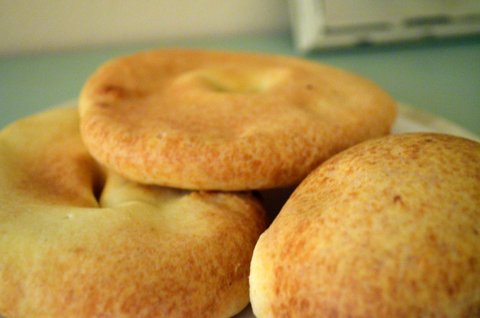Working near the diamond district has its perks. It’s not the big shiny rocks, nor the feeling that everybody is trying to hustle me that excites me about the mysterious culture of the district. What draws me there time and again is its hidden, yet growing scene of kosher food from around the world. Yesterday, I ventured to a restaurant called Ariel Glatt Restaurant. They have no website, just a menu, no decor, no sign on the door. A similar place across the street at least has a man wearing a sandwich board handing out pamphlets. Ariel specializes in Uzbek food, incorporating some Tatar traditions.
When I walk down the street in the diamond district, especially with my male coworkers, you have to evade the men thinking you’re naive ring shoppers. You also have to fend off men asking if you’re selling and just focus on the door numbers. Yesterday, when a man stopped to ask if we were selling gold or diamonds, I noticed the number above his head. Though disappointed, he saw that he had helped us find our destination and said “It’s a good thing I stopped you then, huh?” After climbing to a shady second floor room above the watch fix-it/gold exchange shop, we opened a wooden door and entered into a pale yellow room with a bunch of tables where the all-male clientele were scattered in groups over delicious piles of meat and rice. The simple plastic table covers reflected the flickering fluorescent white lights. The one other woman in there, the waitress, led us to a table by the wall and dropped two paper menus for us. Pictures of the owners adorn the walls and there are two flat screens, nicer than mine at home, playing Uzbek music videos in succession.
After quickly perusing the menu I ordered the Lula kebab lunch special, which also came with a giant bowl of vegetable soup with various spices in it and a pitted fruit, like an olive, that neither my coworker nor I could figure out. I could not resist the 4 piece manti (giant spiced meat filled dumplings). The manti by far was the star of the meal. I am glad I didn’t order the delicious bread that is always recommended, as the manti in and of itself was more than enough for me. The food reminded me of home. The rice was good, the kebabs were delicious, the soup tasted like home, but the manti made me want to come back again. Everything about his meal felt authentic in a way that makes you feel like you’re a part of something not open to everyone. For me, the feeling that someone in Uzbekistan is probably sitting at the same table in front of the same food made this meal, for lack of a better word, awesome.
We were all set to order chuk chuk for dessert, especially when curiosity got the better of me at work and I happened upon this video (watch it with the sound on. These girls really know how to beat an egg. Fun quiz, see if you can spot the random man stand-in at 4:55). We were too full and had taken too much time to indulge in a plate of chuk chuk this outing. We’ll have to go back next week.
Something about the quantity of heavy food for lunch yesterday combined with my binge drinking in the evening really upset my stomach. Today I really couldn’t eat much. This evening I forced myself out to Flushing, Queens to play tennis (I’m on a team that just clinched the #1 spot and made it to playoffs) and on my way home, I got off at Jackson Heights. I really needed homemade chicken soup, or caldo, the broth cure for all stomach and alcohol-related ailments in Latin America. I knew that right on the corner of the 74th street subway station I could hit up La Abundancia Colombian bakery and pick up some soup for dinner, with chicken, noodles and rice. I also took home two pan de bonos, a type of Colombian bread made of corn flour, cassava starch, cheese and eggs, and two almohabanas (kind of the same as pan de bono, but different shape and maybe without the cheese). They are delicious and not terribly difficult to make. See recipe below. I cannot really accurately describe what it’s like to walk through the incredible mix of cultures and food that Jackson Heights has to offer. I could live there for a year and still not try all of the Indian, Nepalese, Colombian, Mexican, Peruvian, etc. food carts and restaurants that line the streets. Nor could I stop in every shop that sells the ingredients imported in order to make all of these foods. I feel at home in this area, however, there are some serious socio-economic issues facing the neighborhood. This article sums it up very well. To give you an idea of what it’s like there I recommend the movie “Maria Full of Grace” about a Colombian drug trafficker, which takes place on the same block where I like to eat. It doesn’t worry me at all that I don’t think I’ve ever been there in the daytime (just don’t tell Grandma). Like any neighborhood, most people are just going about their business and if you stay where the lights are (or cops are), and use your judgment it’s completely fine.
All of this delicious food is making me look forward to having my favorite homemade Colombian soups, ajiaco for dinner and changua for breakfast with a cup of tinto around holiday time. Maybe soon I’ll try my hand at both of them.
Recipe for Pan de Bono
Ingredients
(12 pan de bonos)
2/3 cup cassava starch or yuca flour
1/4 cup precooked cornmeal or masarepa
1 cup Mexican queso freso or Colombian quesito
1 1/4 cup feta cheese
1 large egg
Directions
1. Pre-heat the oven to 400°F.
2. In a food processor, place the yuca flour, cheese and masarepa. Process until well combined. Add the egg slowly while food processor is running.
3. Divide the mixture into 12 equal sized portions, shaping them into balls.
4. Place on a baking sheet lined with parchment paper and bake for about 15 to 20 minutes or until golden on top. Serve warm.

